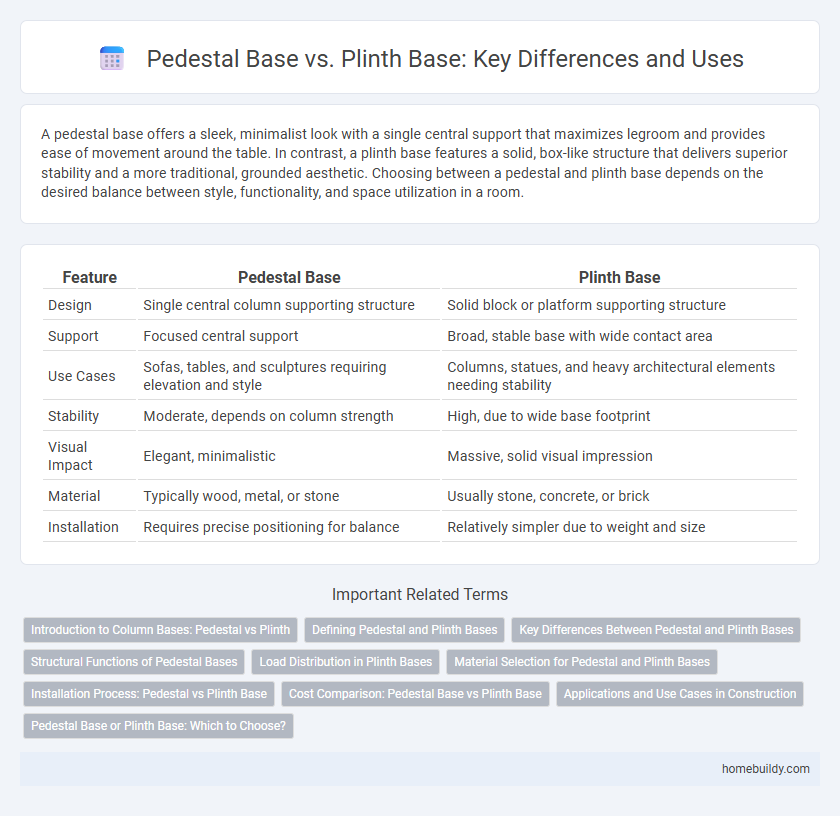A pedestal base offers a sleek, minimalist look with a single central support that maximizes legroom and provides ease of movement around the table. In contrast, a plinth base features a solid, box-like structure that delivers superior stability and a more traditional, grounded aesthetic. Choosing between a pedestal and plinth base depends on the desired balance between style, functionality, and space utilization in a room.
Table of Comparison
| Feature | Pedestal Base | Plinth Base |
|---|---|---|
| Design | Single central column supporting structure | Solid block or platform supporting structure |
| Support | Focused central support | Broad, stable base with wide contact area |
| Use Cases | Sofas, tables, and sculptures requiring elevation and style | Columns, statues, and heavy architectural elements needing stability |
| Stability | Moderate, depends on column strength | High, due to wide base footprint |
| Visual Impact | Elegant, minimalistic | Massive, solid visual impression |
| Material | Typically wood, metal, or stone | Usually stone, concrete, or brick |
| Installation | Requires precise positioning for balance | Relatively simpler due to weight and size |
Introduction to Column Bases: Pedestal vs Plinth
Pedestal bases provide elevated support for columns, enhancing structural stability and aesthetic prominence in architectural designs, commonly used in classical and modern constructions. Plinth bases serve as a broader, flat platform, distributing the column's load evenly to the foundation, often found in masonry and heavier column installations. Understanding the differences between pedestal and plinth bases is essential for selecting the appropriate support mechanism based on load requirements and design intent.
Defining Pedestal and Plinth Bases
A pedestal base is a vertical support structure that elevates a column or statue, typically featuring a narrower top and wider bottom for stability and visual emphasis. In contrast, a plinth base is a flat, block-like foundation that provides a solid, level platform supporting the entire weight of the column or structure above it. Pedestal bases often enhance decorative appeal, while plinth bases prioritize structural stability and uniform load distribution.
Key Differences Between Pedestal and Plinth Bases
Pedestal bases typically feature a single central column that supports a structure, providing an elevated and symmetrical appearance, while plinth bases are usually broader, rectangular or square, designed to distribute weight evenly at the foundation. Pedestal bases often emphasize verticality and ornamental design, whereas plinth bases prioritize stability and load-bearing capacity. Material composition differs as well; pedestals are frequently crafted from sculpted stone or metal, and plinths are constructed with solid masonry or concrete to enhance durability.
Structural Functions of Pedestal Bases
Pedestal bases provide robust structural support by evenly distributing the column's load to the foundation, preventing settlement and enhancing stability. Their design accommodates both vertical and lateral forces, making them ideal for supporting large or heavy columns in architectural and engineering applications. Unlike plinth bases, pedestal bases often incorporate reinforced concrete or masonry materials to resist bending and shear stresses effectively.
Load Distribution in Plinth Bases
Plinth bases provide superior load distribution by spreading the column's weight over a larger area, reducing stress on the foundation soil compared to pedestal bases. The extended footprint of a plinth base helps prevent uneven settlement and increases overall structural stability. This makes plinth bases especially effective for supporting heavy loads on softer or less stable ground conditions.
Material Selection for Pedestal and Plinth Bases
Pedestal bases are predominantly crafted from durable materials such as marble, granite, and reinforced concrete to ensure structural support and aesthetic appeal. Plinth bases often utilize solid stone, brick, or cast stone, chosen for their load-bearing capacity and resistance to weathering in outdoor applications. Material selection for both pedestal and plinth bases depends on factors like compressive strength, durability, and compatibility with the column material to maintain stability and longevity.
Installation Process: Pedestal vs Plinth Base
Pedestal bases typically require anchored installation with bolts or screws into a solid foundation, ensuring stability for columns in both indoor and outdoor settings. Plinth bases involve a simpler installation process, often resting directly on a concrete or masonry platform without extensive anchoring, making them ideal for decorative or less load-bearing applications. The choice between pedestal and plinth base installation depends on structural requirements, load capacity, and site conditions, influencing foundation preparation and securing methods.
Cost Comparison: Pedestal Base vs Plinth Base
Pedestal bases typically cost less than plinth bases due to simpler design and reduced material requirements, making them a budget-friendly option for column foundations. Plinth bases demand more concrete and reinforcing steel, leading to higher project expenses, but they offer enhanced stability for heavier loads. Cost-effective decisions depend on structural requirements and architectural preferences when choosing between pedestal and plinth bases.
Applications and Use Cases in Construction
Pedestal bases are commonly utilized in structural columns where elevated support and load distribution are critical, such as in bridges, large buildings, and monuments, providing stability and resistance against lateral forces. Plinth bases are primarily applied in architectural columns for aesthetic enhancement and foundational support in residential buildings, verandas, and garden structures, offering a robust platform that blends with the structure's design. Both bases optimize load transfer to the foundation but suit different construction needs based on structural demands and visual requirements.
Pedestal Base or Plinth Base: Which to Choose?
Pedestal bases offer a sleek, elevated support ideal for showcasing sculptures or architectural elements with a modern appeal, while plinth bases provide a solid, grounded foundation that enhances stability and complements traditional designs. When choosing between pedestal and plinth bases, consider the weight of the object, desired visual impact, and the setting's architectural style to ensure harmony and durability. Pedestal bases typically suit contemporary spaces seeking minimalism, whereas plinth bases are preferred for classic environments requiring robust structural support.
pedestal base vs plinth base Infographic

 homebuildy.com
homebuildy.com